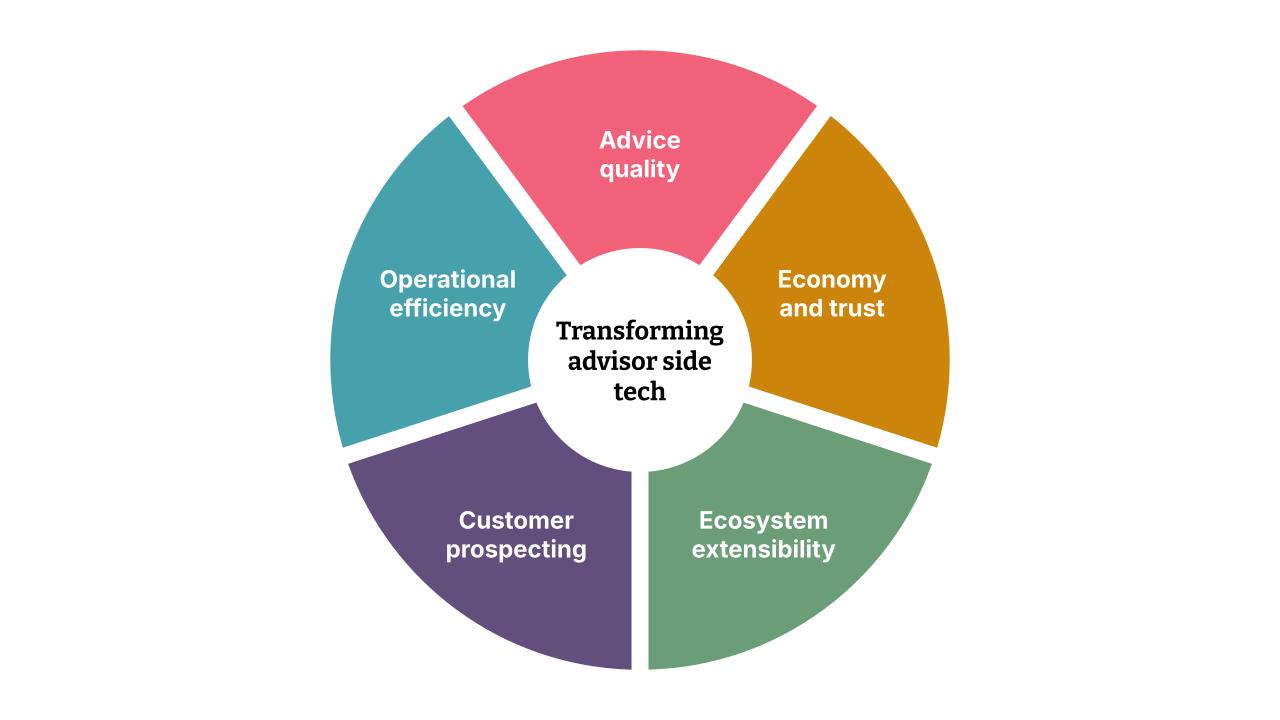Achieving a competitive edge for your advisors
Top performing wealth management firms share one particular thing in common: they spend 25% less on operations and 10% more on client service when compared to average firms (as per a 2024 Charles Schwab study). What helps them do this is the effective use of digital technology — as the same Charles Schwab study emphasizes, technologies including CRM, financial planning and portfolio management systems have a significant impact on wealth management companies' ROI.
The competitive advantage that modern digital advisor-side technology offers, then, cannot be ignored. We believe the modernization approach should consist of:
An enhanced CRM for better prospecting.
A platform that modernizes the end-to-end value stream.
Enhanced data capabilities that can deliver meaningful insights and personalize the advice process.
Optimized delivery value stream to reduce time to market for new features.
Active exploration of the capabilities of generative AI (Gen AI) to gain competitive advantage.
Training your back office and operations team on the new systems and solutions so that they do not fall back on old ways of doing things (old workflows and excel sheets).
Below we’ll explore some of the key trends and challenges in wealth management and why it’s important for firms to effectively empower their advisors — doing so is crucial for achieving higher profitability.
Trends and challenges with advisor side tech
The number of ultra-high-net-worth individuals (UHNIs) is expected to rise by a staggering 25% by 2028 in North America, 38% in Asia and 28% in the Middle East, according to Knight Frank’s wealth report from 2024. The number of individuals with substantial wealth has increased. Their collective assets have expanded, signifying a robust environment for wealth creation.
Interestingly, affluent clients strongly prefer human advisors and are willing to pay five times more for their expertise. This preference is even stronger among high-net-worth individuals, and their willingness to pay a premium has significantly increased. The younger generations, the digital natives, are leaning towards a digital-first approach, but still value human connection and advice. Technology modernization for advisor enablement will benefit both customer segments.
However, the industry is at a technological crossroads. Many institutions are failing to provide advisors with the modern tools they need, hindering productivity and frustrating tech-savvy younger advisors who seek technology to enhance client relationships, not create more red tape.
The current wealth management landscape is plagued by inefficiency. Advisors spend a large portion of their time on manual back-office tasks and a staggering majority of registered investment advisors (RIAs) lack basic digital communication tools. This technological deficit limits advisors' offerings and growth potential. Additionally, the back office faces serious inefficiencies, with many manual processes and legacy systems that require constant firefighting which in turn has resulted in poor client experience with instances like clients not being informed about advice implementation or a simple change to client data requiring updates to multiple disparate systems.
The future of wealth management demands a blend of advanced technology to streamline operations and meet evolving client preferences, while still capitalizing on the enduring value and trust of human advice.
Where are the opportunities?
Technology opportunities for a typical advisor lie across the wealth management value stream — right from helping advisors find more clients (the CRM system), to helping customers onboard, to having productive client meetings, all the way into portfolio research, construction and optimization and client servicing. Each of these areas, when optimized with modern technology, can bring about productivity improvements helping advisors spend a large amount of their time in finding new customers or advising their existing clients — not in grappling with outdated technology.
Each of these areas have been disrupted by new technology. For instance, by leveraging data and AI, WealthTech firms are helping advisors personalize their recommendations and cross-sell products. This is a massive opportunity; modernizing advisor side technology leveraging modern technology can provide huge productivity gains, the advisors will have better relationships with their clients and the wealth management firm gains in the process.
Here are some of the key benefits we foresee from this technology transformation:
Advice quality. Improvement in the quality of advice — a modern end-to-end platform of common, shared and reusable capabilities that are driven by data and AI helps advisors with tailored conversations and meetings with the customer, niche Gen AI solutions help advisors conduct better research and eventually design stronger and contextual portfolios.
Economy and trust. Avoiding the cost of maintaining legacy systems and the reputation damage and regulatory penalties caused by security incidents, outages and non-compliance. The maintenance cost of legacy technology can easily be 80% of a firm’s IT budget. Legacy systems also make it hard to comply with ever-evolving regulations that require greater levels of transparency and clear disclosures. This has been the case with the UK's Consumer Duty regulation and with many more regulations around the globe. Modernization ensures adapting to new regulations is easy.
Ecosystem extensibility. A modern platform, apart from being reliable, also helps wealth management firms onboard newer capabilities at short notice while making it easier to remain secure, resilient and performant. This could mean adding new integrations with an alternative assets provider or tax advice services. The platform rises to new emerging trends in wealth management.
Customer prospecting. A modern CRM system like Salesforce has helped increase operational productivity by 25% by leveraging features like Financial Services Cloud. Also, an AI-enabled application provides the advisor with a complete view of their prospects’ digital DNA, based on things like demographic and geographic data, thus helping advisors to identify prospects with the highest potential and have better and more context-informed conversations with them.
Operational efficiency. Advisors spend a large portion of their time on manual back office tasks. Modernization frees up advisor time by enabling automation of most back office processes.


Make modernization pay for itself
Make modernization pay for itself. Pursue an incremental approach where capabilities that offer more value or return on investment are strangled and modernized earlier into production. Be ruthless in decommissioning features and capabilities that add diminishing value. Use SaaS products for faster time to market for undifferentiated capabilities. But most importantly incrementally improve the quality of your data and implement measures to avoid any degradation in data quality. You will reduce both the risk and the cost of modernization.
Thoughtworks is uniquely positioned to drive modernization at wealth management firms having built modern cloud based data driven platforms for some of the leading wealth management firms globally.
Our modernization solutions have helped cut customer onboarding time by over 90%, helped firms launch industry pioneering solutions & develop data solutions leveraging the Data mesh concept for global wealth management firms with siloed data challenges. Additionally, with deep expertise in both AI and data, we deliver end-to-end solutions that prioritize high-value use cases, and transition AI from proof-of-concept to production, ensuring your AI investments reach maturity and achieve sustainable ROI.
With deep expertise at every stage of the AI development and implementation process, we help build the right data architectures, fine-tune your models, and bring even your most ambitious AI concepts into production.


















